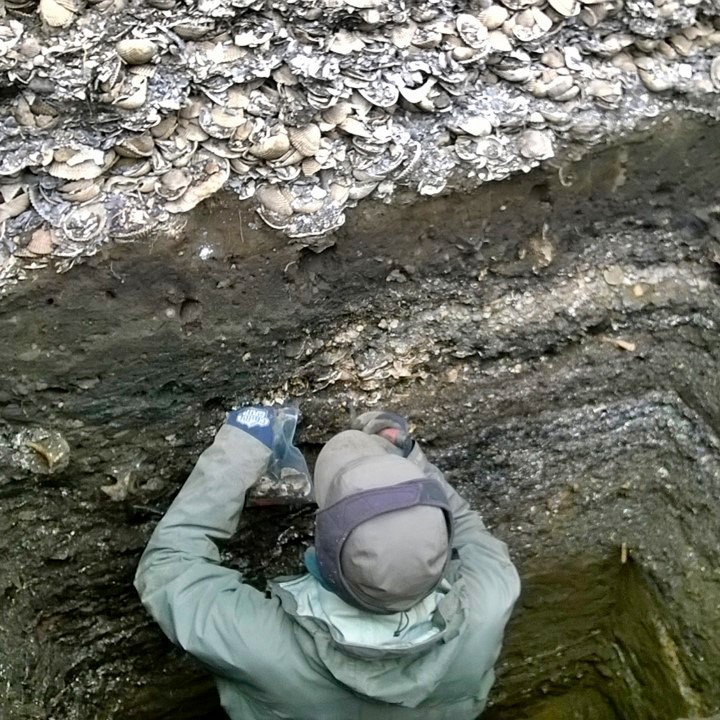March 16, 2021
by Caroline Funk

Layers of sediment, rich with marine animal bone, are excavated from an archaeological midden on the Alaska peninsula. Photo by Nicole Misarti.
Lead Investigators: Julie Avery, Nicole Misarti, Caroline Funk, and Lorrie Rea
Welcome to our new five-year project. The lead members of the research team share a common interest in identifying long term patterns to form understandings of current cultural, environmental, and ecological situations, and in modeling future outcomes. Funk specializes in culture-focused archaeological research including zooarchaeology, Misarti focuses on environment and ecology through chemical analysis of faunal materials, and Avery and Rea focus on patterns in historical and contemporary sea mammal health and well-being.
Our broad research team includes archaeologists at the Museum of the North in Fairbanks and three other repositories, NOAA marine mammal specialists, volcanologists, laboratory research staff and graduate and undergraduate students. This team will grow as we identify interests and needs, and as stakeholders choose to join the effort. We deliberately and intentionally invite comment and contribution from Unangax^ community members and others with collaborative interests.
We are studying the history of mercury in the marine food web in the Aleutian Islands region. Mercury is one of the top 10 contaminants of concern for human health. It is also a contaminant of concern for other members of our ecological community including the three sentinel species in our study: Pacific cod, Steller sea lions, and northern fur seals.
Mercury is in our world and it always has been. Inorganic mercury introduced to water and eventually to coastal systems is methylated by microbes into mono methyl mercury – the more neurotoxic form of mercury – which is biologically accessible in the food web. Prey species that consume mercury bioaccumulate it in their bodies over their lifetimes. Predator species in the food web consume large numbers of prey species, which biomagnifies the amount of mercury in their bodies over their lifetimes. Fish eating predators show greater mercury exposure generally, and so our study focuses on three of the long-lived fish-eating top predator species in the Aleutian Islands food web.
Chronic exposure to even low doses of mercury can have long lasting effects on individual members of a population and on broader scale population dynamics. Negative impacts include reduced health and impaired cognition, decreased pup survival, and lower reproductive rates.
The amount of environmental mercury available for bioaccumulation and biomagnification changes over time.
We are using archaeological and historic faunal materials to look at changing patterns in mercury levels over four thousand years in the Aleutian Islands. As we track these changing patterns and learn more about broad scale food web implications, we should all be very glad that Unangax^ village middens exist. Bone is an ideal tissue for long-term mercury studies because mercury is stored in bone throughout an organism’s lifetime. Archaeological bone preservation is remarkably robust in ancestral Unangax^ middens. Bone is also ideal because it provides two distinct windows of time in each sample: compact bone, the older exterior bone remodels very slowly, while spongy bone, the fresh new developing bone inside, remodels 5-10 times quicker. For each bone, we can look at long term life history or more recent exposure to mercury respectivel.
This is an important study, because most people intuitively believe that the fluorescence of industry in the last few hundred years introduced a new and incredibly productive source of mercury into subarctic and arctic atmospheric and coastal systems.
We approach the test of this intuitive assumption with two contrasting perspectives – and one coupled, likely, scenario:
Future blog posts will explore sources of mercury in the Aleutian Islands, laboratory techniques and processing, and introduce members of our research team. For more information about the project we invite you to visit our presentations and posters page. We do warmly welcome you to contact us if you are interested in learning more about the project or cooperating with us.
Bioaccumulation
Net increase of a toxin in an organism over time. Long-lived animals bioaccumulate more toxins than short-lived animals. In this case that toxin is mercury.
Biomagnification
An increase of the concentration of the toxin when an animal with a higher position (trophic level) in a food chain (food web) eats other species that contain the toxin.